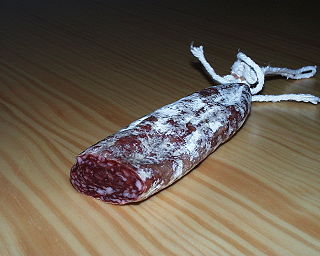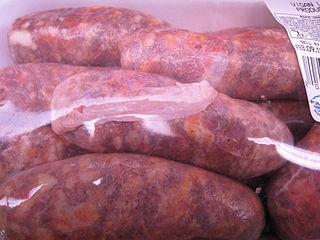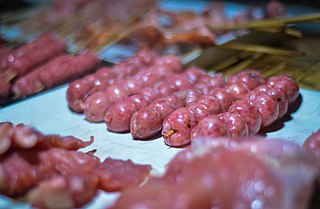
Longaniza is a Spanish sausage (embutido) similar to a chorizo and also closely associated with the Portuguese linguiça. Its defining characteristics are interpreted differently from region to region. It is popular in the cuisines of several regions of Spain, Argentina, Uruguay, Puerto Rico, Dominican Republic, El Salvador, Guatemala, Mexico and Chile. In the Philippines, it is called longganisa and has hundreds of variants with different vernacular tastes and forms due to the 144 ethno-linguistic groups of the archipelago. Longaniza essentially tracks the spread of Latin culture around the world. Longaniza derives from Lucanica, a sausage from Lucania in Southern Italy that was adopted by the Latins of Ancient Rome through military contact. From there it spread to Spain, and from Spain, centuries later, to every place in the world with modern "Latin" culture.

Hamonado, or hamonada, is a Filipino dish consisting of meat marinated and cooked in a sweet pineapple sauce. It is a popular dish during Christmas in Philippine regions where pineapples are commonly grown. Hamonado is also a general term for savory dishes marinated or cooked with pineapple in the Philippines.

Embutido, or embotido, is a Philippine meatloaf made with ground pork and stuffed with hard-boiled eggs and sliced ham or various sausages. It is traditionally wrapped in aluminum foil and steamed, though it can also be baked.

Morcon or morconito is a Philippine braised beef roulade made with beef flank steak stuffed with hard-boiled eggs, carrots, pickled cucumber, cheese, and various sausages. It is commonly served during Christmas and other festive occasions.
Alaminos longganisa, also known as longganisa Pangasinan, is a Filipino pork sausage originating from Alaminos, Pangasinan. It is a type of de recadolongganisa.

Vigan longganisa, also known as the Ilocano longganisa, is a Filipino pork sausage originating from Vigan City, Ilocos Sur. It is a type of de recadolongganisa noted for its salty, garlicky, and sour flavor. It is air-dried, made with ground lean pork, annatto, coarsely ground pork and fat, brown sugar, garlic, onions, bay leaves, soy sauce, vinegar, black pepper, and salt to taste in hog casings. Chili flakes may also be added. The sausages are celebrated in an annual "Longganisa Festival" in Vigan City.

Chorizo de Bilbao, also known as Chorizo Bilbao, is a type of Philippine pork and beef dry sausage. It was originally produced by Spanish Filipino Vicente Genato of the Genato Commercial Corporation in Manila and the name is a genericized trademark originating from the branding coined by Genato from his family's original home city of Bilbao, Spain.

Chorizo de Macao, sometimes called Chinese Chorizo or Longaniza Macau, is a Filipino dry pork sausage. The ingredients of Chorizo de Macao is identical to other Filipino sweet longganisas, except for its dry texture and its use of star anise, aniseed, or anise liqueur (anisado), which gives it its distinctive aroma and its name. It is commonly used in Chinese Filipino dishes like pancit Canton and siopao. It is sometimes confused with and used in place of Chinese sausage.

Chorizo de Cebu, also known as longganisa de Cebu, is a Filipino pork sausage originating from Cebu. It is a type of hamonada (sweet) longganisa. They are distinctively red in color due to the use of achuete seeds. Each link is also usually spherical in shape. It is made from ground lean pork, ground pork fat, salt, saltpeter, sugar, anise liqueur (anisado), paprika, black pepper, garlic, and chilis to taste in a hog casing. It can also be made without the casing. They are usually fried or grilled and eaten with white rice, puso, or garlic rice for breakfast.
Chorizo negrense, also known as chorizo de Bacólod, is a Filipino smoked pork sausage originating from Bacolod, Negros. It comes in two flavors: hamonado (sweet) and recado (garlicky). It can be prepared smoked in a casing, or prepared fresh without the casing. It is made with ground pork, vinegar, garlic, calamansi, soy sauce, black pepper, and coarse salt. Sugar is added to the hamonado version.
Longganisa de Guinobatan is a Filipino pork sausage originating from the town of Guinobatan in Albay, Philippines. It is a type of de recadolongganisa. Each link is typically only 2 inches (5.1 cm) in length. It is made from lean pork, pork fat, salt, sugar, garlic, saltpeter, and black pepper. Unlike other Philippine sausages, the meat is uniquely chopped by hand. The dish is celebrated in the annual "Longganisa Festival" of Guinobatan.

Calumpit longganisa, also known as longganisang bawang, is a Filipino pork sausage originating from Calumpit, Bulacan, Philippines. It is a type of de recadolongganisa. It is made with lean pork, pork fat, garlic, bay leaves, brown sugar, soy sauce, vinegar, salt, black pepper, paprika, and optionally, chili.

Pampanga longganisa is a Filipino pork sausage originating from the province of Pampanga. It is a type of hamonado (sweet) longganisa. It is typically longer and thinner than other Philippine sausages. It is made with pork, garlic, brown sugar, black pepper, coarse salt, and vinegar. It can be prepared with or without the casing. It is typically dyed orange or red with achuete seeds. It is the most common sweet-type longganisa eaten throughout the Philippines, since it is commercially mass-produced.

Lucban longganisa is a Filipino pork sausage originating from Lucban, Quezon. It is a type of de recadolongganisa. It is characterized by its use of oregano and its garlicky and sour taste. It is made with coarse and lean pork, pork fat, coarse salt, onions, garlic, oregano, paprika, peppercorns, sugar, and vinegar. It can be prepared with or without the sausage casing.

A chori burger, also known as a chorizo burger, is a Filipino hamburger characteristically made with chorizo (longganisa) patties, banana ketchup, mayonnaise, and atchara, in addition to tomatoes and lettuce. It was first popularized by Merly's BBQ, a street food stall in the island of Boracay in the Philippines. A version of the burger with a half-longganisa and half-beef patty from Jeepney Restaurant was declared the best burger in New York City in Time Out's 2014 "Battle of the Burgers" competition.

Chicken longganisa is a Filipino fresh sausage made with minced chicken meat, garlic, onion, soy sauce, muscovado sugar, salt, vinegar, and black pepper. Vegetable extenders can also be added like carrots, turnips, or jicamas. It is sold as a healthier alternative to other kinds of longganisa. It is usually prepared without the casing ("skinless"), and is molded into shape with the use of wax paper.

Guagua longganisa, also known as Candaba longganisa, is a Filipino pork sausage originating from the towns of Guagua and Candaba, Pampanga. It is a type of de recadolongganisa characterized by its salty and sour taste because of its heavier use of vinegar in comparison to other Filipino sausages.
Fish longganisa, or fish chorizo, is a Filipino sausage made with fish instead of pork or beef. It is typically made from tuna, tilapia, or milkfish. It is prepared identically to other Filipino longganisa and is marketed as a healthier alternative. It may use regular pork casings, vegetable-based casings, or be prepared "skinless".
Baguio longganisa is a Filipino pork sausage originating from the city of Baguio. It is a type of hamonado (sweet) longganisa.















